Name Saint Joseph | Nationality Roman Spouse Mary | |
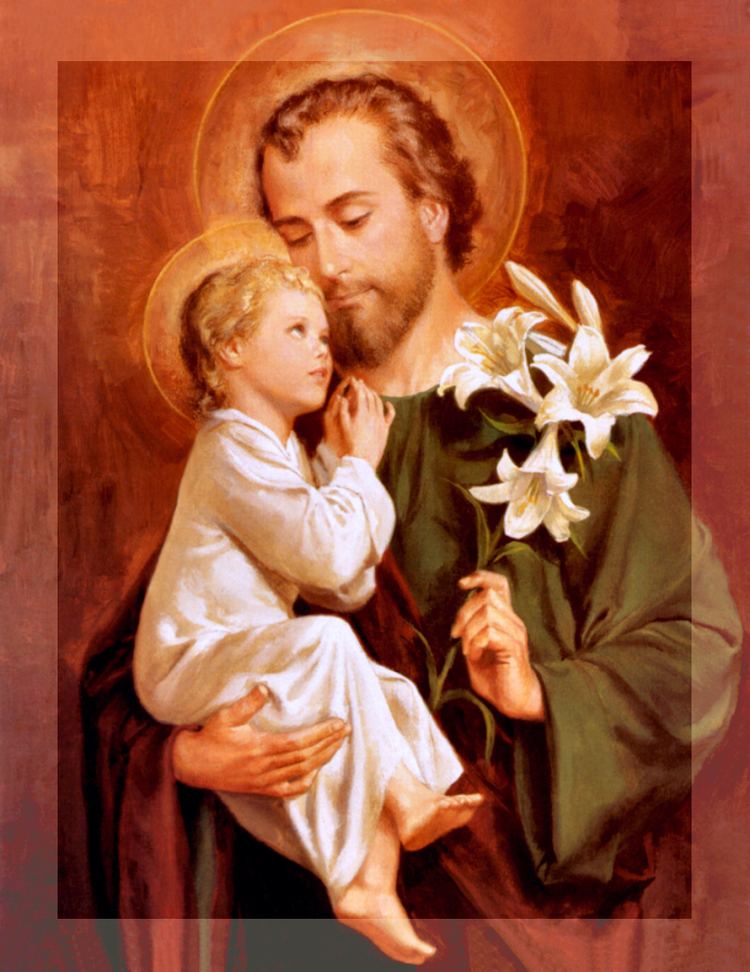 | ||
Venerated in Catholic Church, Anglican Communion, Lutheranism, Methodism, Eastern Orthodox Church, Oriental Orthodox Church Feast March 19 - Saint Joseph, Husband of Mary (Western Christianity), May 1 - St Joseph the Worker (Roman Catholic Church),The Sunday after the Nativity of the Lord (Eastern Christianity) Attributes Carpenter's square or tools, the infant Jesus, staff with lily blossoms, two turtle doves, rod of spikenard. Patronage Catholic Church, unborn children, fathers, immigrants, workers, employment, carpenters, realtors, against doubt and hesitation, and of a happy death, Canada, Croatia, Korea, Vietnam, and many others. Similar People Mary, Saint Anne, Saint Peter, James, Joachim | ||
A powerful novena to saint joseph
Joseph (Hebrew: יוֹסֵף, Yosef; Greek: Ἰωσήφ, Ioséph) is a figure in the Gospels, the husband of Mary, mother of Jesus, and is venerated as Saint Joseph in the Catholic Church, Orthodox Church, Oriental Orthodox Church, Anglican Communion, Lutheranism and Methodism. Christian tradition places Joseph as Jesus' legal father. Some historians state that Joseph was Jesus' father. Some differing views are due to theological interpretations versus historical views.
Contents
- A powerful novena to saint joseph
- The Passion of Saint Joseph
- In the New Testament
- Gospel harmony
- Lineage
- Professional life
- Modern appraisal
- Later apocryphal writings
- Veneration
- Feast days
- Patronage
- Places churches and Institutions
- Prayers and devotions
- In art
- References

In both Catholic and Protestant traditions, Joseph is regarded as the patron saint of workers and is associated with various Feast days. However, protestants in general reject the veneration and invocation of the Saints.. Pope Pius IX declared him to be both the patron and the protector of the Catholic Church, in addition to his patronages of the sick and of a happy death, due to the belief that he died in the presence of Jesus and Mary. In popular piety, Joseph is regarded as a model for fathers and has also become patron of various dioceses and places.
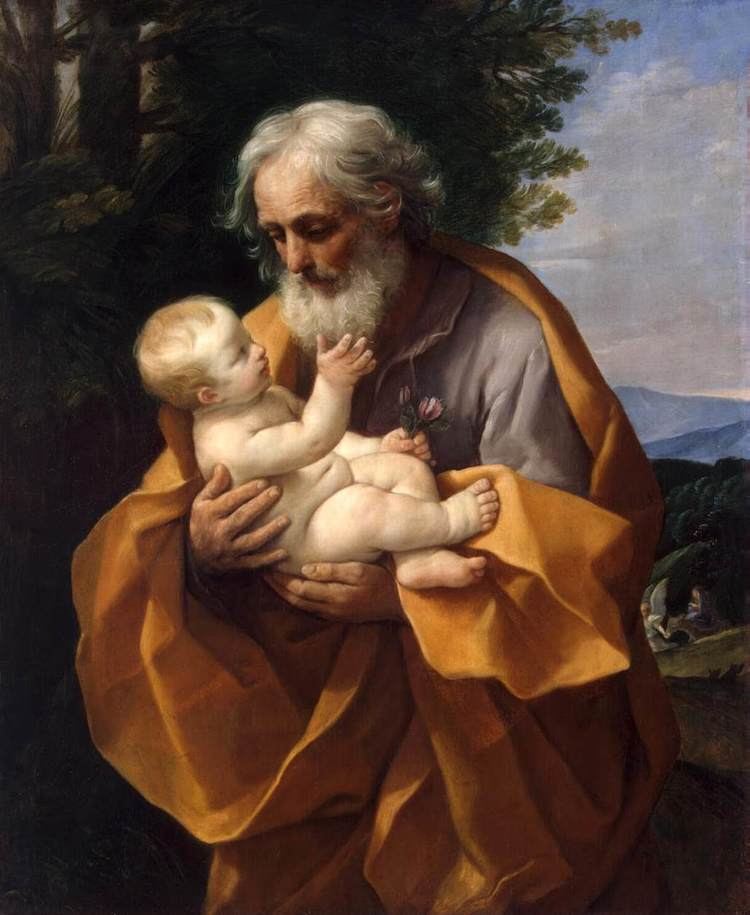
Several notable images of Saint Joseph have been granted a Canonical coronation by a pope. In popular religious iconography he is associated with lilies or a spikenard. With the present-day growth of Mariology, the theological field of Josephology has also grown and since the 1950s centers for studying it have been formed.
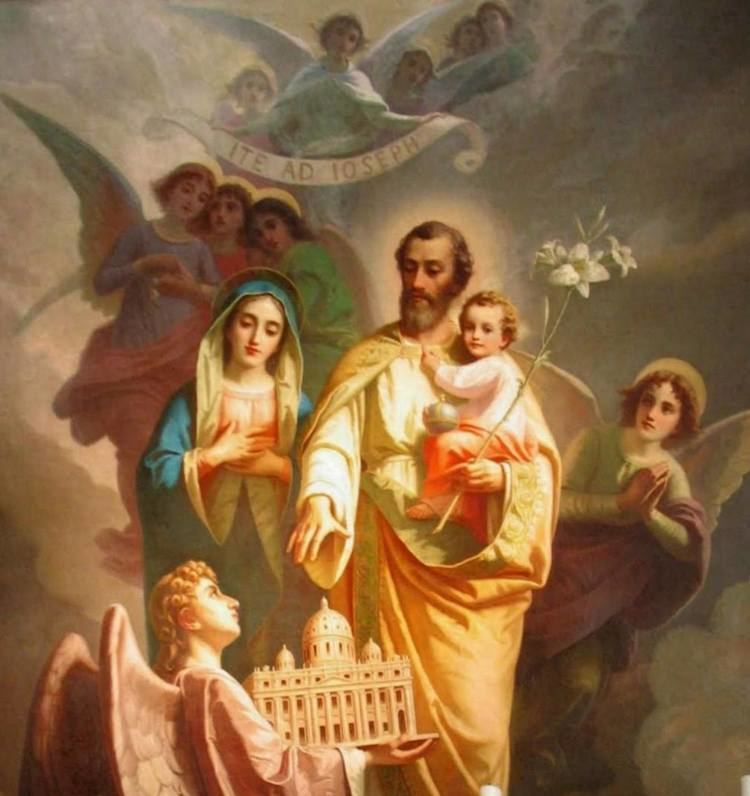
In the New Testament Joseph was the father of James, Joses, Jude, Simon, and at least two daughters, which, according to Epiphanius and the apocryphal History of Joseph the Carpenter, were from a marriage before that of Mary. This belief is accepted only by some Christian denominations.
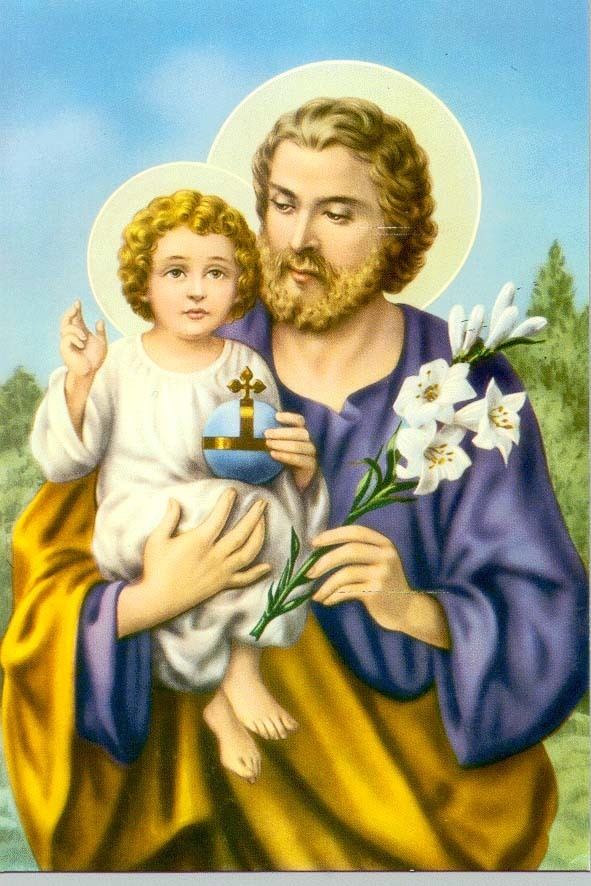
The Passion of Saint Joseph
In the New Testament
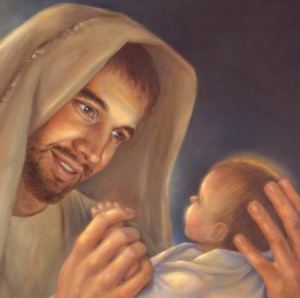
The Pauline epistles make no reference to Jesus' father; nor does the Gospel of Mark. The first appearance of Joseph is in the gospels of Matthew and Luke. Each contains a genealogy of Jesus showing ancestry from king David, but through different sons; Matthew follows the major royal line from Solomon, while Luke traces another line back to Nathan, another son of David and Bathsheba. Consequently, all the names between David and Joseph are different. Some scholars, such as Harry A. Ironside reconcile the genealogies by viewing the Solomonic lineage in Matthew as Joseph's major royal line, and the Nathanic lineage in Luke to be Mary's minor line.
The epistles of Paul are generally regarded as the oldest extant Christian writings. These mention Jesus' mother (without naming her), but do not refer to his father. The Book of Mark, the first gospel to be written, with a date about two decades after Paul, also does not mention Jesus' father. Joseph first appears in the Gospels of Matthew and Luke, both dating from around 80-90 AD. The issue of reconciling the two accounts has been the subject of debate.
Like the two differing genealogies, the infancy narratives appear only in Matthew and Luke and take different approaches to reconciling the requirement that the Messiah be born in Bethlehem with the tradition that Jesus in fact came from Nazareth. In Matthew, Joseph obeys the direction of an angel to marry Mary. Following the Birth of Jesus in Bethlehem, Joseph and family stay in Bethlehem for an unspecified period (perhaps two years) until after the visit of the Three Magi, when Joseph is told by an angel in a dream to take the family to Egypt to escape the massacre of the children of Bethlehem planned by Herod, the ruler of the Roman province of Judea. Once Herod has died, an angel tells Joseph to return, but to avoid Herod's son he takes his wife and the child to Nazareth in Galilee and settles there. Thus in Matthew, the infant Jesus, like Moses, is in peril from a cruel king, like Moses he has a (fore)father named Joseph who goes down to Egypt, like the Old Testament Joseph this Joseph has a father named Jacob, and both Josephs receive important dreams foretelling their future.
In Luke, Joseph already lives in Nazareth, and Jesus is born in Bethlehem because Joseph and Mary have to travel there to be counted in a census. Subsequently, Jesus was born there. Luke's account makes no mention of angels and dreams, the Massacre of the Innocents, or of a visit to Egypt.
The last time Joseph appears in person in any Gospel is in the story of the Passover visit to the Temple in Jerusalem when Jesus is 12 years old, found only in Luke. No mention is made of him thereafter. The story emphasizes Jesus' awareness of his coming mission: here Jesus speaks to his parents (both of them) of "my father," meaning God, but they fail to understand.(Luke 2:41-51).
Christian tradition represents Mary as a widow during the adult ministry of her son. Joseph is not mentioned as being present at the Wedding at Cana at the beginning of Jesus' mission, nor at the Passion at the end. If he had been present at the Crucifixion, he would under Jewish custom have been expected to take charge of Jesus' body, but this role is instead performed by Joseph of Arimathea. Nor would Jesus have entrusted his mother to the care of John the Apostle if her husband had been alive.
While none of the Gospels mentions Joseph as present at any event during Jesus' adult ministry, the synoptic Gospels share a scene in which the people of Nazareth, Jesus' hometown, doubt Jesus' status as a prophet because they know his family. In Mark 6:3, they call Jesus "Mary's son" instead of naming his father. In Matthew, the townspeople call Jesus "the carpenter's son," again without naming his father. (Matthew 13:53-55) In Luke 3:23 "And Jesus himself began to be about thirty years of age, being (as was supposed) the son of Joseph, which was [the son] of Heli."(Luke 4:16-30) In Luke the tone is positive, whereas in Mark and Matthew it is disparaging. This incident does not appear at all in John, but in a parallel story the disbelieving neighbors refer to "Jesus the son of Joseph, whose father and mother we know" (John 6:41-51).
Gospel harmony
Joseph is mentioned in the gospels of Matthew, Luke, and John. Mark's gospel contains no reference to this Joseph by name.
Lineage
Joseph appears in Luke as the father of Jesus and in a "variant reading in Matthew". Matthew and Luke both contain a genealogy of Jesus showing his ancestry from David, but through different sons; Matthew follows the major royal line from Solomon, while Luke traces another line back to Nathan, another son of David and Bathsheba. Consequently, all the names between David and Joseph are different. According to Matthew 1:16 "Jacob begat Joseph the husband of Mary", while according to Luke 3:23, Joseph is said to be "the son of Heli".
The variances between the genealogies given in Matthew and Luke are explained in a number of ways, although one possibility is that Matthew's genealogy traces Jesus' legal descent, according to Jewish law, through Joseph; while Luke's genealogy traces his actual physical descent through Mary.
Professional life
The gospels describe Joseph as a "tekton" (τέκτων). Tekton has been traditionally translated into English as "carpenter", but is a rather general word (from the same root that gives us "technical" and "technology") that could cover makers of objects in various materials. The Greek term evokes an artisan with wood in general, or an artisan in iron or stone. But the specific association with woodworking is a constant in Early Christian tradition; Justin Martyr (died c. 165) wrote that Jesus made yokes and ploughs, and there are similar early references.
Other scholars have argued that tekton could equally mean a highly skilled craftsman in wood or the more prestigious metal, perhaps running a workshop with several employees, and noted sources recording the shortage of skilled artisans at the time. Geza Vermes has stated that the terms 'carpenter' and 'son of a carpenter' are used in the Jewish Talmud to signify a very learned man, and he suggests that a description of Joseph as 'naggar' (a carpenter) could indicate that he was considered wise and highly literate in the Torah.
At the time of Joseph, Nazareth was an obscure village in Galilee, about 65 kilometres (40 mi) from the Holy City of Jerusalem, which is barely mentioned in surviving non-Christian texts and documents. Archaeology over most of the site is made impossible by subsequent building, but from what has been excavated and tombs in the area around the village, it is estimated that the population was at most about 400. It was, however, only about 6 kilometres from the city of Tzippori (ancient "Sepphoris"), which was destroyed by the Romans in 4 BC, and thereafter was expensively rebuilt. Analysis of the landscape and other evidence suggest that in Joseph's lifetime Nazareth was "oriented towards" the nearby city, which had an overwhelmingly Jewish population although with many signs of Hellenization, and historians have speculated that Joseph and later Jesus too might have traveled daily to work on the rebuilding. Specifically the large theatre in the city has been suggested, although this has aroused much controversy over dating and other issues. Other scholars see Joseph and Jesus as the general village craftsmen, working in wood, stone and metal on a wide variety of jobs.
Modern appraisal
The name "Joseph" is found almost exclusively in the genealogies and the infancy narratives. Modern positions on the question of the relationship between Joseph and the Virgin Mary vary. The Eastern Orthodox Church, which names Joseph's first wife as Salome, holds that Joseph was a widower and merely betrothed, but never married, to Mary, and that references to Jesus' "brothers" are to children of Joseph and Salome. The position of the Catholic Church, derived from the writings of Saint Jerome, is that Joseph was the husband of Mary, but that references to Jesus' "brothers" should be understood to mean cousins or step-brothers. In both cases, the church doctrine of the Perpetual Virginity means that Joseph and Mary never had sexual relations. The Protestant churches, following the tenet of Virgin Birth but not that of Perpetual Virginity, hold no strong views on the subject.
The term kiddushin, which refers to the first part of a two-part marriage, is frequently translated as "betrothal". Couples who fulfil the requirements of the kiddushin are married, until death or divorce.
Later apocryphal writings
The canonical gospels created a problem: they stated clearly that Mary was a virgin when she conceived Jesus, and that Joseph was not his father; yet Joseph's paternity was essential to establish Jesus' Davidic descent. The theological situation was complicated by the gospel references to Jesus' "brothers and sisters" (repeated in Paul, where James is called the "brother of Christ"), and by the fact that Jesus was described unambiguously by John and Mark as "Joseph's son" and "the carpenter's son." From the 2nd century to the 5th writers tried to explain how Jesus could be simultaneously the "son of God" and the "son of Joseph".
The first to offer a solution was the apocryphal Protoevangelium of James, written about 150 AD. The original gospels never refer to Joseph's age, but the author presents him as an old man chosen by lot (i.e., by God) to watch over the Virgin. Jesus' brothers are presented as Joseph's children by an earlier marriage, and his years and righteousness explain why he has not yet had sex with his wife: "I received her by lot as my wife, and she is not yet my wife, but she has conceived by the Holy Spirit."
The Protoevangelium was extremely popular, but it leaves open the possibility that Joseph might have had relations with Mary after the birth of Jesus ("she is not yet my wife..."). A few centuries later the developing doctrine that Mary was a virgin not only at the time of the conception and birth of Christ, but throughout her life, meant that this possibility had to be excluded.
The apocryphal History of Joseph the Carpenter, written in the 5th century and framed as a biography of Joseph dictated by Jesus, describes how Joseph, aged 90 (the Protoevangelium had not given Joseph a specific age), a widower with four sons and two daughters, is given charge of the twelve-year-old Mary, who then lives in his household raising his youngest son James the Less (the supposed author of the Protoevangelium) until she is ready to be married at age 14½. Joseph's death at the age of 111, attended by angels and asserting the perpetual virginity of Mary, takes up approximately half the story.
According to the bishop of Salamis, Epiphanius, in his work The Panarion (AD 374-375) "Joseph became the father of James and his three brothers (Joses, Simeon, Judah) and two sisters (a Salome and a Mary) or (a Salome and an Anna) with James being the elder sibling. James and his siblings were not children of Mary but were Joseph's children from a previous marriage. After Joseph's first wife died, many years later when he was eighty, "he took Mary (mother of Jesus)".
Eusebius of Caesarea relates in his Church History (Book III, ch. 11) that "Hegesippus records that Clopas was a brother of Joseph and an uncle of Jesus." Epiphanius adds that Joseph and Cleopas were brothers, sons of "Jacob, surnamed Panther."
The Catholic Encyclopedia citing the texts contained in the apocryphal writings writes that:
When forty years of age, Joseph married a woman called Melcha or Escha by some, Salome by others; they lived forty-nine years together and had six children, two daughters and four sons, the youngest of whom was James (the Less, "the Lord's brother"). A year after his wife's death, as the priests announced through Judea that they wished to find in the tribe of Judah a respectable man to espouse Mary, then twelve to fourteen years of age. Joseph, who was at the time ninety years old, went up to Jerusalem among the candidates; a miracle manifested the choice God had made of Joseph, and two years later the Annunciation took place. These dreams, as St. Jerome styles them [...] are void of authority; they nevertheless acquired in the course of ages some popularity; in them some ecclesiastical writers sought the answer to the well-known difficulty arising from the mention in the Gospel of "the Lord's brothers"; from them also popular credulity has, contrary to all probability, as well as to the tradition witnessed by old works of art, retained the belief that St. Joseph was an old man at the time of marriage with the Mother of God.
Veneration
The earliest records of a formal devotional following for Saint Joseph date to the year 800 and references to him as Nutritor Domini (educator/guardian of the Lord) began to appear in the 9th century, and continued growing to the 14th century. Saint Thomas Aquinas discussed the necessity of the presence of Saint Joseph in the plan of the Incarnation for if Mary had not been married, the Jews would have stoned her and that in his youth Jesus needed the care and protection of a human father.
In the 15th century, major steps were taken by Saint Bernardine of Siena, Pierre d'Ailly and Jean Gerson. Gerson wrote Consideration sur Saint Joseph and preached sermons on Saint Joseph at the Council of Constance. In 1889 Pope Leo XIII issued the encyclical Quamquam pluries in which he urged Catholics to pray to Saint Joseph, as the patron of the Church in view of the challenges facing the Church.
Josephology, the theological study of Saint Joseph, is one of the most recent theological disciplines. In 1989, on the occasion of the centenary of Quamquam pluries Pope John Paul II issued Redemptoris custos (Guardian of the Redeemer), which presented Saint Joseph's role in the plan of redemption, as part of the "redemption documents" issued by John Paul II such as Redemptoris Mater to which it refers.
Together with the Blessed Virgin Mary and the Child Jesus, Joseph is one of the three members of the Holy Family; since he only appears in the birth narratives of the Gospels, Jesus is depicted as a child when with him. The formal veneration of the Holy Family began in the 17th century by François de Laval.
In 1962, Pope John XXIII inserted the name of Joseph in the Canon of the Mass, immediately after that of the Blessed Virgin Mary. In 2013, Pope Francis had his name added to the three other Eucharistic Prayers.
Feast days
March 19, Saint Joseph's Day, has been the principal feast day of Saint Joseph in Western Christianity since the 10th century, and is celebrated by Catholics, Anglicans, many Lutherans and other denominations. In Eastern Orthodoxy, the feast day of Saint Joseph is celebrated on the First Sunday after the Nativity of Christ. In the Roman Catholic church, the Feast of St. Joseph (19 March) is a solemnity (first class if using the Tridentine calendar), and is transferred to another date if impeded (i.e., 19 March falling on Sunday or in Holy Week).
In 1870, Pope Pius IX declared Joseph patron of the universal Church and instituted another feast, with an octave, to be held in his honour on Wednesday in the second week after Easter. This was abolished by Pope Pius XII, when in 1955 he established the Feast of "St. Joseph the Worker", to be celebrated on 1 May. This date joins with the May Day (International Workers' Day), a union, workers' and socialists' holiday commemorating the Haymarket affair in Chicago, and reflects Joseph's status as what many Catholics and other Christians consider the "patron of workers" and "model of workers." Catholic and other Christian teachings and stories about or relating to Joseph and the Holy Family frequently stress his patience, persistence, courage, and hard work.
The Feast of Saint Joseph the Worker (1 May) is an Optional Memorial, and so is omitted if impeded, unless the day is raised to a higher rank because Saint Joseph is the patron of the church, diocese, place, or institution. (However, the 1 May celebration is 1st class in the Tridentine calendar, so in it Saint Joseph the Worker was celebrated on 2 May in 2008 because 1 May was Ascension Thursday and in 2011 because 1 May was in the Easter octave.)
Patronage
Pope Pius IX proclaimed Saint Joseph the patron of the Universal Church in 1870. Having died in the "arms of Jesus and Mary" according to Catholic tradition, he is considered the model of the pious believer who receives grace at the moment of death, in other words, the patron of a happy death.
Saint Joseph is the patron saint of a number of cities, regions and countries, among them the Americas, Austria, Belgium, Canada, China, Croatia, Mexico, Korea, Peru, the Philippines and Vietnam, as well as of families, fathers, expectant mothers (pregnant women), travelers, immigrants, house sellers and buyers, craftsmen, engineers, and working people in general.
Places, churches and Institutions
Many cities, towns, and locations are named after Saint Joseph. According to the National Geospatial-Intelligence Agency, the Spanish form, San Jose, is the most common place name in the world. Probably the most-recognized San Joses are San José, Costa Rica, and San Jose, California, United States, given their name by Spanish colonists. Joseph is the patron saint of the New World; and of the regions Carinthia, Styria, Tyrol, Sicily; and of several main cities and dioceses.
Many churches, monasteries and other institutions are dedicated to Saint Joseph. Saint Joseph's Oratory is the largest church in Canada, with the largest dome of its kind in the world after that of Saint Peter's Basilica in Rome. Elsewhere in the world churches named after the saint may be known as those of San Giuseppe, e.g. San Giuseppe dei Teatini, San José, e.g. Metropolitan Cathedral of San José or São José, e.g. in Porto Alegre, Brazil.
The Sisters of St. Joseph were founded as an order in 1650 and have about 14,013 members worldwide. In 1871, the Josephite Fathers of the Roman Catholic Church were created under the patronage of Joseph, intending to work with the poor. The first Josephites in America re-devoted their part of the Order to ministry within the newly emancipated African American community. The Oblates of St. Joseph were founded in 1878 by St. Joseph Marello. In 1999 their Shrine of Saint Joseph the Guardian of the Redeemer was named after the Apostolic exhortation Redemptoris Custos.
Prayers and devotions
In the Eastern Orthodox Church, during the feast day of Saint Joseph the following hymn is chanted:
In the Catholic tradition, just as there are prayers for the Seven Joys of Mary and Seven Sorrows of Mary, so there are also prayers for the seven joys and seven sorrows of Saint Joseph; these include prayers for daily protection, vocation, happy marriage, happy death, and hopeless cases; specific prayers, novenas and devotions include the Prayer to Saint Joseph and the Novena to Saint Joseph. St. Francis de Sales included Saint Joseph along with Virgin Mary as saints to be invoked during prayers in his Introduction to the Devout Life, Saint Teresa of Avila attributed her recovery of health to Saint Joseph and recommended him as an advocate, and Saint Therese of Lisieux stated that for a period of time, every day she prayed to "Saint Joseph, Father and Protector of Virgins..." and felt safe and protected from danger as a result, and Pius X composed a prayer to Saint Joseph which begins:
There is a belief that planting a statue of St. Joseph on a house will help sell the house.
In art
Up to about the 17th century Joseph tends to be depicted as a man advanced in years, with grey hair, often balding, occasionally frail, a comparatively marginal figure alongside Mary and Jesus if not entirely in the background, passive other than when leading them on their flight to Egypt. Joseph is shown mostly with a beard, not only in keeping with Jewish custom, but also because – although the Gospel accounts do not give his age – later literature tends to present him as an old man at the time of his wedding to Mary. This depiction arose to allay concerns about both the celibacy of the newly wedded couple, the mention of brothers and sisters of Jesus in the canonical Gospels, and Joseph's other children spoken of in apocryphal literature – concerns discussed very frankly by Jean Gerson for example, who nonetheless favoured showing him as a younger man.
In recent centuries – in step with a growing interest in Joseph's role in Gospel exegesis – he himself has become a focal figure in representations of the Holy Family. He is now often portrayed as a younger or even youthful man (perhaps especially in Protestant depictions), whether going about his work as a carpenter, or participating actively in the daily life of Mary and Jesus as an equal and openly affectionate member. Art critic Waldemar Januszczak however emphasises the preponderance of Joseph's representation as an old man and sees this as the need, " to explain away his impotence: indeed to symbolise it. In Guido Reni's Nativity, Mary is about 15, and he is about 70 - for the real love affair - is the one between the Virgin Mary and us. She is young. She is perfect. She is virginal - it is Joseph's task to stand aside and let us desire her, religiously. It takes a particularly old, a particularly grey, a particularly kindly and a particularly feeble man to do that. ...Banished in vast numbers to the backgrounds of all those gloomy stables in all those ersatz Bethlehems, his complex iconographic task is to stand aside and let his wife be worshipped by the rest of us." However Carolyn Wilson challenges the long-held view that pre-Tridentine images were often intended to demean him. According to Charlene Villaseñor Black, "Seventeenth-century Spanish and Mexican artists reconceptualized Joseph as an important figure, ... representing him as the youthful, physically robust, diligent head of the Holy Family." Bartolomé Esteban Murillo's The Two Trinities, Saint Joseph is given the same prominence as the Virgin.
Full cycles of his life are rare in the Middle Ages, although the scenes from the Life of the Virgin or Life of Christ where he is present are far more often seen. The Mérode Altarpiece of about 1425, where he has a panel to himself, working as a carpenter, is an early example of what remained relatively rare depictions of him pursuing his métier.
Some statues of Joseph depict his staff as topped with flowers, recalling the non-canonical Protoevangelion's account of how Mary's spouse was chosen by collecting the walking sticks of widowers in Palestine, and Joseph's alone bursting into flower, thus identifying him as divinely chosen. The Golden Legend, which derives its account from the much older Gospel of Pseudo-Matthew, tells a similar story, although it notes that all marriageable men of the Davidic line and not only widowers were ordered by the High Priest to present their rods at the Temple. Several Eastern Orthodox Nativity icons show Joseph tempted by the Devil (depicted as an old man with furled wings) to break off his betrothal, and how he resists that temptation. There are some paintings with him wearing a Jewish hat.
